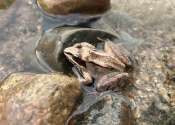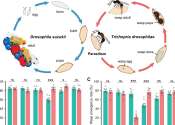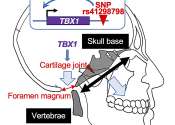In biology, evolution is change in the genetic material of a population of organisms from one generation to the next. Though changes produced in any one generation are small, differences accumulate with each generation and can, over time, cause substantial changes in the population, a process that can culminate in the emergence of new species. Indeed, the similarities amongst species suggest that all known species are descended from a common ancestor (or ancestral gene pool) through this process of gradual divergence .
The basis of evolution is the genes that are passed on from generation to generation; these produce an organism's inherited traits. These traits vary within populations, with organisms showing heritable differences (variation) in their traits. Evolution itself is the product of two opposing forces: processes that constantly introduce variation, and processes that make variants either become more common or rare. New variation arises in two main ways: either from mutations in genes, or from the transfer of genes between populations and between species. In species that reproduce sexually, new combinations of genes are also produced by genetic recombination, which can increase variation between organisms.
Two major mechanisms determine which variants will become more common or rare in a population. One is natural selection, a process that causes helpful traits (those that increase the chance of survival and reproduction) to become more common in a population and causes harmful traits to become more rare. This occurs because individuals with advantageous traits are more likely to reproduce, meaning that more individuals in the next generation will inherit these traits. Over many generations, adaptations occur through a combination of successive, small, random changes in traits, and natural selection of the variants best-suited for their environment. The other major mechanism driving evolution is genetic drift, an independent process that produces random changes in the frequency of traits in a population. Genetic drift results from the role that chance plays in whether a given trait will be passed on as individuals survive and reproduce.
Evolutionary biologists document the fact that evolution occurs, and also develop and test theories that explain its causes. The study of evolutionary biology began in the mid-nineteenth century, when studies of the fossil record and the diversity of living organisms convinced most scientists that species changed over time. However, the mechanism driving these changes remained unclear until the theories of natural selection were independently discovered by Charles Darwin and Alfred Wallace. Darwin's landmark work On the Origin of Species of 1859 brought the new theories of evolution by natural selection to a wide audience. Darwin's work soon led to overwhelming acceptance of evolution among scientists. In the 1930s, Darwinian natural selection was combined with Mendelian inheritance to form the modern evolutionary synthesis, which connected the units of evolution (genes) and the mechanism of evolution (natural selection). This powerful explanatory and predictive theory directs research by constantly raising new questions, and it has become the central organizing principle of modern biology, providing a unifying explanation for the diversity of life on Earth.









